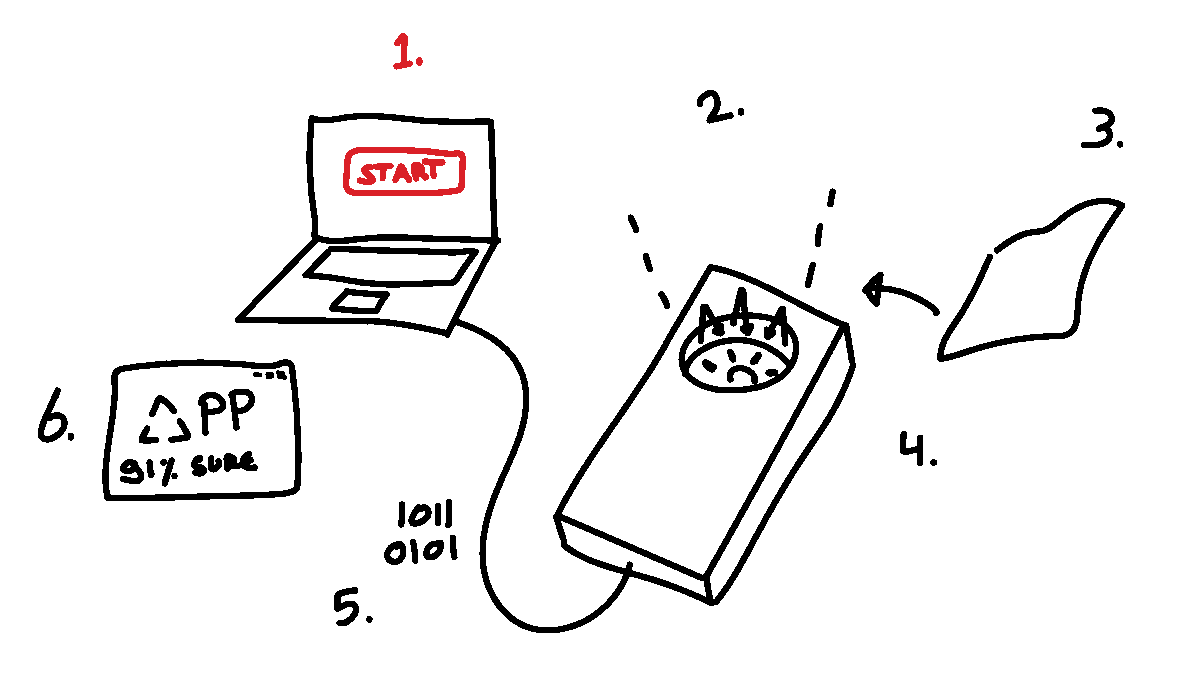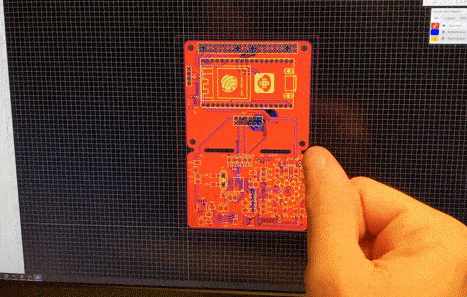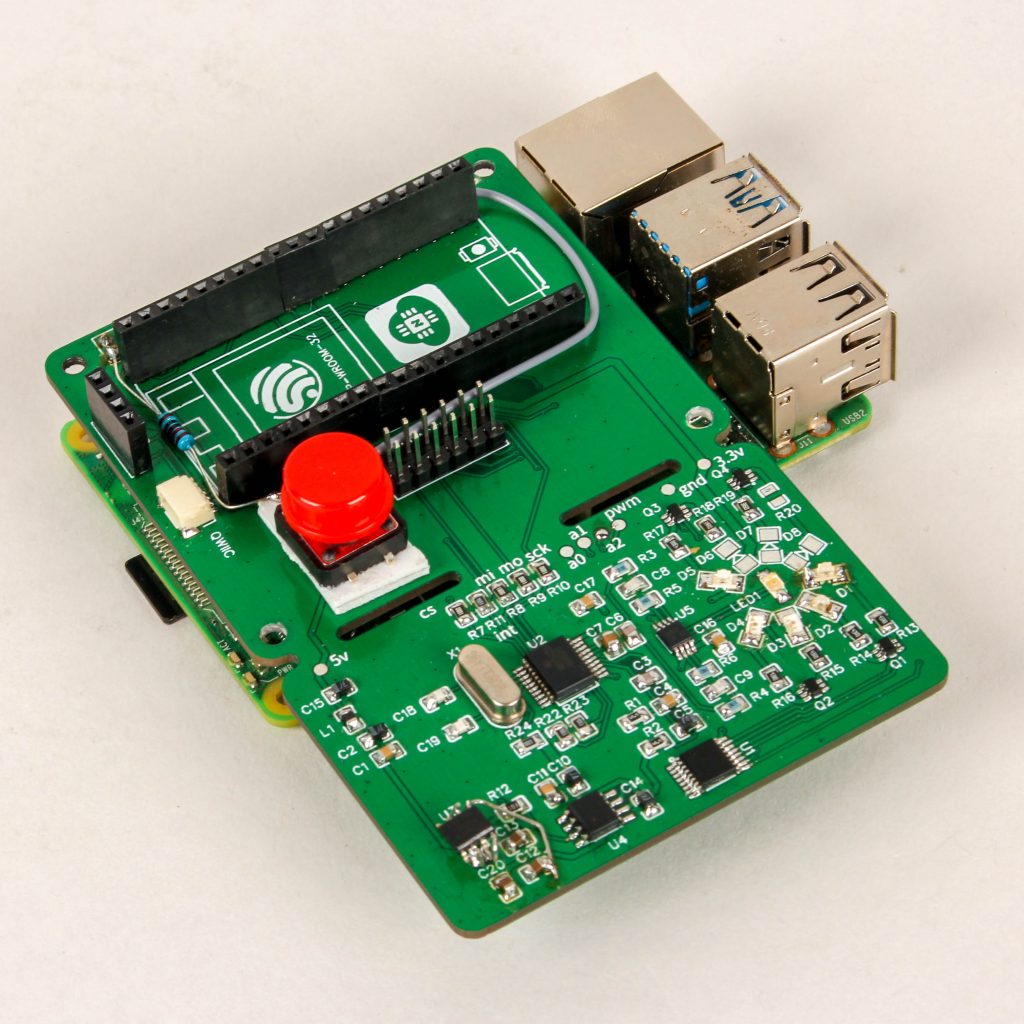Okay people, I have been talking long enough now, let’s get our feet in the plastic and start working on a solution! In a previous post I talked about discrete infrared spectroscopy, an example of this is the ReReMeter, which will also be the foundation of this project.
To predict the type of plastic the ReReMeter goes through the following steps:
- the user tells the machine that it wants to take a measurement
- the machine takes premeasurements to measure the ambient light conditions
- A sample is placed on the ReReMeter
- The ReReMeter flashes different LEDs one by one and takes measurements
- The ReReMeter communicates this data to the computer
- A machine-learning algorithm uses the measured data to make a prediction on what type of plastic it is!

Now that Straller and Gessler proved the technology and we know what steps are required for plastic identification, we can focus more on the nitty-gritty details of a Plastic Scanner. For the development of the Plastic Scanner, we formulated a few design values, namely: Design for local manufacturing, design for context variation, and design for open development. With these values, we believe it is possible to develop a sustainable product that can be implemented by many.🤟
👷The implication of Local Manufacturing on the development of a Plastic Scanner.
Okay, let’s be realistic, not everyone is such a hardcore nerd as me, that has all tools in house to build a Plastic Scanner. But MakerSpaces and FabLabs are community workspaces, do have quite some tools! And the best thing is that you can find them anywhere around the world. Let’s take these as a benchmark that needs to be able to build a Plastic Scanner. Next to that, we can use standardized components, so normal bolts and nuts for example, and no odd size ;). Lastly, we want the Plastic Scanner to be simple to solder, and again using common electronic components.
🗿The implication of Context Variation on the development of a Plastic Scanner.
If we want the Plastic Scanner to be easily implemented by many different people we need to simulate context variation from the start. This showed different potential users, their similarities and differences. It resulted in the idea of making a modular Plastic Scanner, this way people can adapt their Plastic Scanner to their own surroundings. If they want a handheld device (check) if they want multiple next to each other (check). This way everyone can find their best matching Plastic Scanner, and start building it.
🤝The implication of Open Development on the development of a Plastic Scanner.
The ReReMeter already aced this topic! they have a super complete GitHub repo that contains all their source files in order to make your own ReReMeter. The goal for the plastic scanner is to definitely keep this mentality and to find more ways to enrich open development. At the moment we can still add building instructions, implementation inspiration, or a place where interested can interact for development or application questions.
Building a Minimal Viable Product (MVP)
The goal of the MVP is to tackle the biggest uncertainties quickly by making something basic that works. It incorporates many of the features derived from the design values and tests if these result in the desired qualities, without compromising on the sensor reading quality.📈

After a few tests with some Arduino’s and cardboard, it was time to develop the first proper printed circuit board (PCB). Compared to the ReReMeter is has Bigger components, a sensor separate from processing, sensor communication over SPI, Connection for I2C peripherals, and a standard Raspberry Pi HAT form factor.
This gave an good idea about the size, the quality, and possible implementation issues. Summery of the findings:
The good:
- The MVP can measure IR light!
- The MVP is fully soldered by hand
- The sensor communicates to a Raspberry Pi over SPI
- Users can interact with the device, it has an input button and a graphical screen
- The MVP is built from standard components
The bad:
- The current form-factor is relatively big
- I made a mistake and one of the components did not fit on the board
For the next version the goal is to keep the same components but improve the layout, allowing the board to shrink a lot, physically separating the sensor from the processing part, reducing the amount of pins required and fix the component issue 😉
I’m back to my workbench for some more nerding, until next time, Jerry ✌



2 replies on “Action.”
What a hopeful project, maybe Many nerds have Many answers in a short amount of time!
Hallo Jerry,
Ik las het artikel in het FD.
Komt dit apparaat ook op de markt of is het alleen maar een studie ?
Ik zit in de kunststof recycling en daar kan een dergelijk apparaat handig zijn.
Met vriendelijke groeten
Leo Driebergen